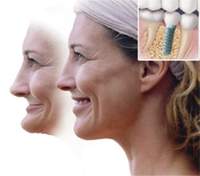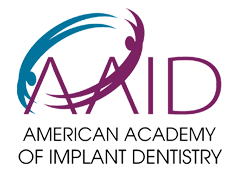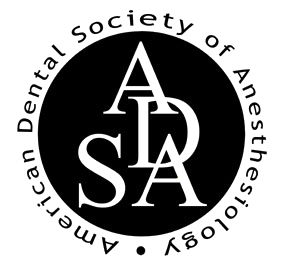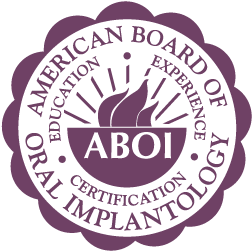We love seeing patients transform their smiles with dental implants and we are always thrilled when patients come to that exciting decision. However, here at Family Implant & Reconstructive Dentistry, we encourage our patients to use caution because their jaw and oral tissues may not be prepared for dental implants immediately. If this happens, supplemental procedures can sometimes be used to provide that extra help patients need to get them ready for oral surgery.
What Are The Problems With Gum Tissue Or Bone Deterioration?

Sample Patient: Rhonda
Rhonda (whose real name has been altered for privacy), is a 55-year-old female patient with three teeth missing in her top front arch. She lost the teeth almost 20 years ago in an auto-accident. After the accident, Rhonda got a dental bridge because it was the quickest and least expensive option. The bridge was fine 20 years ago, but now Rhonda wants to replace her missing teeth with a more permanent and attractive solution. Unfortunately, the tissues around her missing teeth have dramatically receded due to wearing a bridge for so many years. Her doctor determined that she needed tissue grafting before she could get dental implants.
Occasionally, in patients like Rhonda, after years of wearing a bridge, gums can recede, leaving sensitive areas of the root exposed and vulnerable. This can cause greater chances of infection, disease, pain, and decay. So what can be done to combat these? According to dental researchers, tissue grafting has been extremely effective in helping make gums strong, healthy, and resistant to further recession.
Can Tissue Grafting Help Me?
During the actual tissue grafting procedure, a small graft of healthy gum tissue is harvested from the patient’s own mouth. Conveniently, this procedure can be performed concurrent with the dental implant placement or before. The order that these procedures are performed will depend on the patient’s health and oral health goals.
After the specially harvested gum graft material is properly placed in the prepared area, the patient will be sent home to heal. The patient should rest and avoid putting any pressure on the graft area. In time, the graft will preserve the soft tissue in the dental implant area and makes the gum tissues less likely to recede after oral surgery.
Sample Patient: Jim
Jim (whose real name has been altered for privacy), is a 64-year-old male patient with most of the teeth in his lower jaw missing. After a biking accident in his late twenties, Jim got dentures because they were the easiest option. Additionally, he wanted to save money and dental implants were not readily available in the area that he lived. Now, Jim discovered that he wants a more permanent, attractive, and functional solution to replace his damaged teeth. However, x-rays revealed that Jim’s jawbone had flattened out over the years. So what can he do now to repair the damage?
How Can Bone Grafting Help Me?
To combat dangerous bone deterioration and the characteristic flattening of the jawbone after tooth loss, procedures were created to help rebuild healthy jawbone volume. Initially these procedures were designed to help patients simply wear their dentures and chew enough to eat solid foods. Early attempts at bone grafting used large and dense rib bones. These efforts required extensive hospital stays and painful skin grafts to prevent the displacement of the bone graft when the patient moved, talked, or chewed. The early procedures were usually ineffective, painful, and often unsuccessful.
Thanks to years of thorough research, careful experimentation, and precise clinical patient trials, patients like Jim can get bone or tissue grafting right in the doctor’s office in just a few short visits. If you think you might need bone grafting, the first step is to schedule an appointment to get evaluated.
Come See Dr. Grubb For Information About Supplemental Procedures
Here at Family Implant & Reconstructive Dentistry we see hundreds of patients just like Jim and Rhonda. And despite the excitement involved in fixing smiles, not all patients are immediately ready for dental implant placement. In years past, a lack of healthy oral tissues could have prevented patients from getting dental implants. Today, thanks to the wonders of bone and tissue grafting, patients like Jim and Rhonda who were previously unable to get implants, can now take advantage of all the benefits of permanent and natural-looking tooth replacement. Today is a wonderful day to begin your journey toward a beautiful smile with dental implants from Dr. Grubb!






